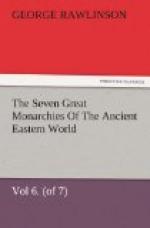The jars, jugs, vases, and lamps greatly resembled those of the Assyrian and Babylonian periods, but were on the whole more elegant and artistic. The forms appended will give a tolerable idea of the general character of these vessels. [PLATE VI. Fig. 4.] They were of various sizes, and appear to have been placed in the tombs, partly as the offerings of friends and well-wishers, partly with the more superstitious object of actually supplying the deceased with the drink and light needful for him on his passage from earth to the realms of the dead.
The glass bottles were, perhaps, lachrymatories. They had no peculiar characteristics, but were almost exactly similar to objects of the same kind belonging to the times of the Assyrian and Babylonian Empires. They exhibited the same lovely prismatic colors, which have been so admired in the glass of those kingdoms, an effect of decomposition, which, elsewhere generally disfiguring, in the case of this material enhances the original beauty of the object tenfold by clothing it in hues of the utmost brilliance and delicacy.
The personal decorations consisted chiefly of armlets, bangles, beads, rings, and ear-rings. They were in gold, silver, copper, and brass. Some of the smaller gold ornaments, such as earrings, and small plates or beads for necklaces and fillets, were “of a tasteful and elegant design.” The finger-rings were coarser, while the toe-rings, armlets, and bangles, were for the most part exceedingly rude and barbarous. Head-dresses in gold, tall and pointed, are said to have been found occasionally; but the museums of Europe have not yet been able to secure any, as they are usually melted down by the finders. Broad ribbons of gold, which may have depended like strings from a cap, are commoner, and were seen by Mr. Loftus. Altogether, the ornaments indicated a strong love of personal display, and the possession of considerable wealth, but no general diffusion of a correct taste, nor any very advanced skill in design or metallurgy.
Of purely aesthetic art—art, that is, into which the idea of the useful does not enter at all—the Parthians appear scarcely to have had an idea. During the five centuries of their sway, they seem to have set up no more than some half dozen bas-reliefs. There is, indeed, only one such work which can be positively identified as belonging to the Parthian period by the inscription which accompanies it. The other presumedly Parthian reliefs are adjudged to the people by art critics merely from their style and their locality, occurring as they do within the limits of the Parthian kingdom, and lacking the characteristics which attach to the art of those who preceded and of those who followed the Parthians in these countries.
[Illustration: PLATE 7.]




